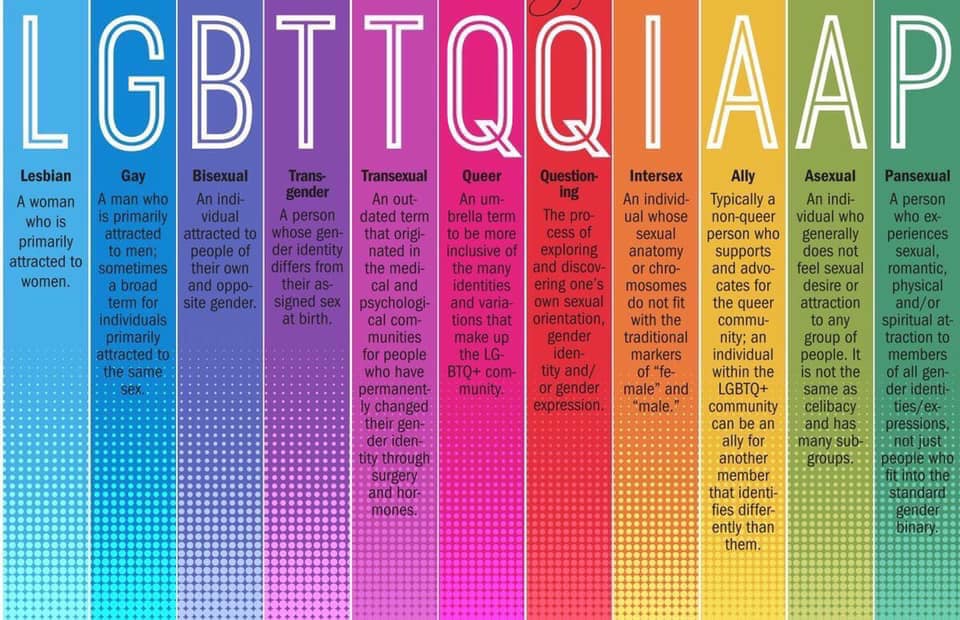Sexual Orientation and gender have been confusing lately. Here in this article, we have defined a few terms for you, which will help you in understanding sexual orientation. We will talk about gender too in another article. Here we will talk about LGBTQIA+: Understanding Sexual Orientation, defining the terms. Many of you guys have requested a topic on the types of sexualities:
What is LGBTQIA+?
A common abbreviation for Lesbian, Gay, Bisexual, Pansexual, Transgender, Genderqueer, Queer, Intersexed, Agender, Asexual, and Ally community. The initialism LGBT is intended to emphasize a diversity of sexuality and gender identity-based cultures.
Sexual Orientation
The sexual orientation of a person is the physical or emotional attraction one feels towards another person. These feelings can be either sexual or romantic or both.
Homosexual
Homosexual people are attracted to people of their own gender. Homose
Gay
Gay is a word used to describe someone who is homosexual. Today, the word usually means a person who is sexually attracted to people of the same sex, and often that person can be also romantically interested in people of the same sex.
Lesbian
A lesbian is a homosexual woman. The word lesbian is also used for women in relation to their sexual identity or sexual behavior, regardless of sexual orientation, or as an adjective to characterize or associate nouns with female homosexuality or same-sex attraction.
Heterosexual
Heterosexuality is romantic attraction, sexual attraction or sexual behavior between persons of the opposite sex or gender.

Straight
The word “straight” is often used to mean “heterosexual.” It can also mean “heteroromantic.” Heterosexual means you’re sexually attracted to the opposite sex only. Hetero romantic means you’re romantically attracted to the opposite sex only.
Bisexual
Bisexuality is romantic attraction, sexual attraction, or sexual behavior toward both males and females, or to more than one sex or gender.
Asexual
Someone who’s asexual experiences little to no sexual attraction. Sexual attraction is about finding a specific person sexually appealing and wanting to have sex with them. However, everyone has a different experience with being asexual, and asexuality can mean different things to different people.
Aromantic
Aromantic people experience little to no romantic attraction. Romantic attraction is about wanting a committed romantic relationship with someone. The definition of “romantic relationship” can differ from person to person. Some aromantic people have romantic relationships anyway.
Pansexual
Pansexuality is sexual, romantic or emotional attraction towards people regardless of their sex or gender identity. Pansexual people may refer to themselves as gender-blind, asserting that gender and sex are not determining factors in their romantic or sexual attraction to others.
Omnisexual
Omnisexual is involving, related to, or characterized by a diverse sexual propensity just like pansexuals.
Demisexual
Demisexuality is a sexual orientation where people only experience sexual attraction to folks that they have close emotional connections with. In other words, demisexual people only experience sexual attraction after an emotional bond has formed
Lithosexual
Lithosexual can be a sexual orientation on its own or can combine with other orientations.
Polysexual
Polysexual is involving or characterized by different sexualities; sexually attracted to more than one gender.
Graysexual
Graysexual — sometimes spelled graysexual — is used to refer to people who experience limited sexual attraction. In other words, they experience sexual attraction very rarely, or with very low intensity.
Homophobia
Homophobia encompasses a range of negative attitudes and feelings toward homosexuality or people who are identified or perceived as being lesbian, gay, bisexual or transgender (LGBT).




